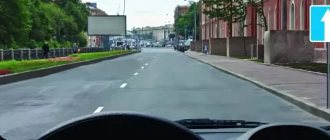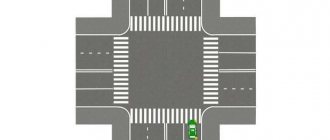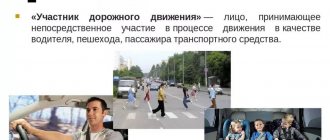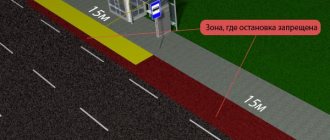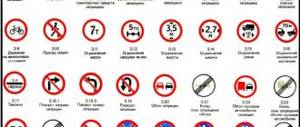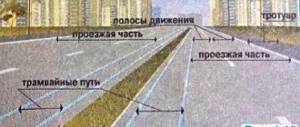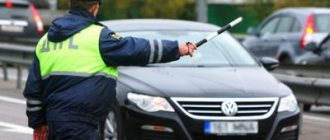When driving a motor vehicle, each driver is obliged to strictly follow the traffic rules established by Government Decree No. 1090 of October 1993.
Dear readers! The article talks about typical ways to resolve legal issues, but each case is individual. If you want to find out how to solve your particular problem , contact a consultant:
+7 (499) 938-81-90 (Moscow)
+7 (812) 467-32-77 (Saint Petersburg)
8 (800) 301-79-36 (Regions)
APPLICATIONS AND CALLS ARE ACCEPTED 24/7 and 7 days a week.
It's fast and FREE !
Amendments are made to this document as necessary. The latest changes took effect on July 1, 2021. How to make a left turn according to the rules, read on.
What trajectory can you continue moving along?
| 1. | For any reason. |
| 2. | Only according to A. |
| 3. | Only by A or B. |
At this intersection there is a sign “Exit to a one-way road”, which does not prohibit movement straight and to the right. When turning, you should move as close as possible to the right edge of the roadway. Consequently, movement at the intersection can only continue along trajectories A and B.
Stopping and parking on a one-way road
We will tell you in this part how to stop correctly on roads where traffic is only in one direction. Many motorists are accustomed to abandoning their car in the middle of the roadway, which makes it difficult for others to move.
Stop and park on the right side of the roadway. According to the Decree of the Government of the Russian Federation dated October 23, 1993 No. 1090, stopping and parking can be carried out if there are no prohibiting factors (signs, stop, pedestrian crossing, etc.). If there is a shoulder that is adjacent to the roadway, then the car must under no circumstances be left on the roadway.
Stopping and parking of vehicles is permitted on the right side of the road on the side of the road, and in its absence - on the roadway at its edge and in the cases established by paragraph 12.2 of the Rules - on the sidewalk. (as amended by Decree of the Government of the Russian Federation dated January 24, 2001 N 67)
Clause 12.1 of traffic rules
Stop and park on the left side of the roadway. There are some nuances here that we will help you sort out. So, parking and stopping in this place is allowed only in a populated area, and there must be no tram tracks. But for trucks with a maximum weight of more than 3.5 tons, only stopping on the left side is allowed.
On the left side of the road, stopping and parking are permitted in populated areas on roads with one lane for each direction without tram tracks in the middle and on one-way roads (trucks with a permissible maximum weight of more than 3.5 tons are allowed on the left side of one-way roads only stopping for loading or unloading).
Clause 12.1 of traffic rules
If the left lane is an oncoming lane for public transport, then any stop or parking for all types of transport is prohibited.
What signs allow you to make a U-turn?
| 1. | Only A. |
| 2. | B and V. |
| 3. | All. |
Sign 3.18.2 “Left turn prohibited” (A) prohibits only a turn, but not a U-turn. Sign 5.7.2 “Exit onto a one-way road” (B) and sign 5.13.2 “Exit onto a road with a lane for route vehicles” (B) also do not prohibit turning around at the intersections of such roads.
5.7.1 “Entering a one-way road”
February 28, 2013 Administrator Home page » Road signs Views:
Regardless of the driver's desire, he periodically has to cross intersections.
The difficulty of driving through these sections of the road is beyond doubt, since the lion's share of the Rules of the Road applies here, and the driver must apply most of his knowledge (if, of course, he has any).
Imagine that a special intersection has appeared in front of you, in front of which there is one of two signs “Exit to a one-way road.”
Initially, let's look at one of them - sign 5.7.1 - with an arrow indicated from left to right. (Looking ahead, let's say that the commentary to sign 5.7.2 will be more similar to this one).
Novice, inexperienced and uninformed drivers may become confused when they see a sign with an arrow that is quite long. Moreover, with a certain degree of probability they will make a mistake in qualifying the indicated sign.
In fact, the sign “Entering a one-way road” carries information that is not at all difficult to understand.
This sign informs the driver that at the intersection he is crossing a one-way road. Moreover, the direction of one-way traffic is determined by that very long white arrow on the blue field of the sign.
From this knowledge, the driver must draw at least two main conclusions.
First. The sign applies only to this intersection (or intersection - exit from the adjacent territory). In other words, outside the intersection the sign no longer regulates traffic.
Second. The sign “Entering a one-way road” strictly prohibits turning left. It is not difficult to guess that the ban is associated with the prospect of deprivation of a driver’s license for driving in the oncoming lane.
After all, judging by the sign, there is one-way traffic on this road. And the arrow on the sign just points in the direction of one-way traffic.
Another very important aspect. Drivers, when they see a sign that interests us, very often make two annoying mistakes that do not lead to traffic violations, but make the driving process less comfortable for the driver.
First mistake. Quite often, drivers perceive the arrow on the sign “Entering a one-way road” as a guide to action. They incorrectly believe that the sign requires a mandatory right turn.
In fact, the arrow is, on the one hand, an informant of the direction of one-way traffic on the intersecting roadway, and on the other, a prohibitive mechanism for turning left (and driving against the “arrow” direction).
Consequently, the sign “Entering a one-way road” does not require a mandatory right turn, but excludes the very possibility of a left turn at the intersection. Therefore, if you indicate your desire to drive straight, this will not be a violation of the Rules.
The second mistake is a consequence of the first. You just need to remember that the indicated sign DOES NOT PROHIBIT TURNING. Ignorance of this principle is a traditional mistake of driving school cadets and unlucky drivers, leading to nervousness and discomfort on the road.
Just remember this rule. And if basic knowledge is not enough for someone, and there is a desire to figure out “why?”, if you please!
At first glance, it would be more logical to prohibit a U-turn, because the trajectory of movement would run towards the arrow (and the possible flow of vehicles).
However, it should be noted that a U-turn is not a “movement”, but a maneuver, and it will not take place on a one-way road, but at an intersection. That is why making a U-turn will not be a traffic violation. Just like moving in any other direction (except turning left).
Thus, the sign “Exit to a one-way road” (5.7.1) indicates the intersection of “our” road with a road on which one-way traffic is organized. In this case, turning left is strictly prohibited and movement in all other directions is permitted.
The content of the article:
- one way traffic sign
- entering a one-way road
- exit sign on a one-way road
- one way traffic sign
Tags: entering a one-way road
What signs allow a U-turn?
| 1. | A and B. |
| 2. | Only A. |
| 3. | All. |
Answer
| Sign A “Move to the left” allows for a U-turn, because Mandatory signs permitting left turns also permit U-turns. |
| Sign B “No left turn” prohibits a left turn, but not a U-turn. |
| Sign B “Entering a one-way road” does not prohibit turning. |
The correct answer is Everything.
What signs allow you to make a left turn?
| 1. | A and B. |
| 2. | B and V. |
| 3. | Only B. |
Answer
| You are allowed to turn left by a dead end sign (B), informing you that this road does not have a through passage. |
| You are allowed to turn left by sign B “Exit onto a road with a lane for fixed-route vehicles,” indicating that on the left lane, towards the main flow of vehicles, there is oncoming traffic of buses and (or) trolleybuses. |
| Sign A “Exit onto a one-way road” allows traffic at the intersection only to the right or straight, although it also allows for a U-turn in the opposite direction, but not a left turn towards oncoming traffic. |
The correct answer is B and C.
Tips for inexperienced drivers
As a rule, most violations related to turning left are committed by inexperienced drivers. This is due, first of all, to insufficient driving experience and, accordingly, the inability to apply traffic rules in practice. Therefore, inexperienced motorists should:
- Spend more time driving. It is better to start driving in places with small traffic flows, as this will help you learn to apply the rules in reality without unnecessary nerves.
- Spend more time studying the theoretical basis. Without basic knowledge of traffic rules (or knowledge of a small number of them), it is impossible to apply them in practice.
- Learn to determine where there is a controlled intersection and where there is not. This will help you apply the rules that apply to a specific road intersection.
In what directions are you allowed to move?
| 1. | Just straight ahead. |
| 2. | Only to the right. |
| 3. | Straight or right. |
In this situation, the traffic controller does not change the existing traffic organization at the intersection. The traffic controller's signal and the road sign "Entering a one-way road" allow you to drive through the intersection only straight or to the right.
In what directions are you allowed to move?
| 1. | Just straight ahead. |
| 2. | Just straight and to the right. |
| 3. | Only straight, left and in the opposite direction. |
| 4. | In any. |
In this situation, the traffic controller does not change the existing traffic organization at the intersection. If you are in the right lane, you can only drive straight through the intersection, as the sign “Entering a one-way road” prohibits turning right. To make a left turn or U-turn, you had to take the left lane.
Which trajectory do the Rules allow you to make a left turn?
| 1. | Only according to A. |
| 2. | Only according to B. |
| 3. | For any reason. |
The “Exit to a one-way road” sign informs that on the roadway being crossed, traffic is carried out not only in the right, but also in the left lane. Therefore, you can turn left along either of the two paths.
Turn left according to traffic rules: Recommendations for the driver
On the road, the driver constantly has to follow the rules, all of which are difficult to keep in mind. Moreover, even compliance with traffic rules does not always guarantee that a motorist will not end up in an accident or receive a fine.
Therefore, sometimes you need to refresh your knowledge and follow advice, for example, on turning left.
At a controlled intersection. First of all, the driver needs to understand what a controlled intersection is. Everything is simple with this - this is an intersection of roads where traffic is regulated using a traffic light or a traffic controller.
Before making a left turn at this intersection, first of all, you need to wait for the permitting signal from the traffic light or traffic controller and only then begin your maneuver. At the same time, you need to know that the driver needs to let cars ahead of him that are moving towards him and that are turning right. To do this, the driver has the right to stop in the middle of the intersection and stand still until it is his turn.
At an uncontrolled intersection. When we talk about an uncontrolled intersection, we mean an intersection of roads where there is neither a traffic light nor a traffic controller. At such intersections, as a rule, you can see signs “Main Road” and “Give Way”.
If a car driver turns off a main road that goes straight ahead, he must give way only to a vehicle moving in the opposite direction. If the driver is driving along the main road and at the same time turns left in the direction of the main road, he should not yield to anyone, since the priority of the road sign is respected.
You can also often see a “Give Way” sign and when turning left you must give way to all road users.
There are also a combination of "Main Road" and "Give Way" signs. So, for example, if a driver is about to turn left and at the same time enter the main road, he will have to let vehicles from all directions pass. This is due to the fact that some cars are already driving on the main road, and the car on the right is an obstacle (the “right hand” rule).
You can often find equivalent road intersections where there are no signs installed that can help the motorist understand his or her starting order. But there are no particular difficulties in this. All you need to remember when turning left on equivalent roads is that you need to give way to cars on the right and moving towards you.
Tram rails. The need to cross tram tracks when turning left often frightens drivers, especially those who are faced with such a situation for the first time and do not remember very well how to make the maneuver correctly.
In fact, making a left turn in such a situation is very simple and does not require much knowledge. It is enough to turn to the legislation and understand that crossing tracks when turning left should be carried out with a preliminary exit onto the “following rails” and continue by crossing tracks in the opposite direction.
Of course, you will have to let the tram through if it is moving along one of the tracks.
The presence of signs and markings indicating permitted directions of movement makes life even easier for drivers. You just need to strictly follow the image on the sign that allows you to turn. For example, if a driver is about to make a left turn and at the same time cross tram tracks and sees a road sign indicating the direction of travel straight ahead and to the left, then he does not need to drive onto passing tram tracks. He must make a turn from his lane and immediately cross the tram tracks.
At a pedestrian crossing. When turning left through a pedestrian crossing, drivers should be as careful as possible, as there may be people there who should definitely be let through and continue driving.
It should be said that turns or U-turns at a pedestrian crossing are strictly prohibited and entail administrative liability. Any maneuvers must be performed before or after the crossing to avoid any violations of the Traffic Rules.
One Way. When turning left and entering a one-way road, drivers must occupy the leftmost lane immediately before the maneuver itself. After making a turn, you can take any lane on a one-way road. In a situation where it is necessary to turn left and exit a one-way road, drivers must also take the leftmost lane and make the turn.
Bottom line. When driving on the road, every driver must follow many rules, which are sometimes simply impossible to remember. However, it is worth following simple tips and especially road signs, because they act as clues. Be attentive and mutually polite - and you will definitely avoid a meeting with a traffic inspector!
What trajectory can you use to make a turn?
| 1. | Only according to A. |
| 2. | Only according to B. |
| 3. | For any reason. |
In this case, a U-turn is prohibited only directly at the pedestrian crossing (trajectory B), the boundaries of which, in the absence of markings, are determined by “Pedestrian crossing” signs. At the intersection (trajectory A), a U-turn can be made, since the “Exit onto a one-way road” sign does not prohibit a U-turn.
